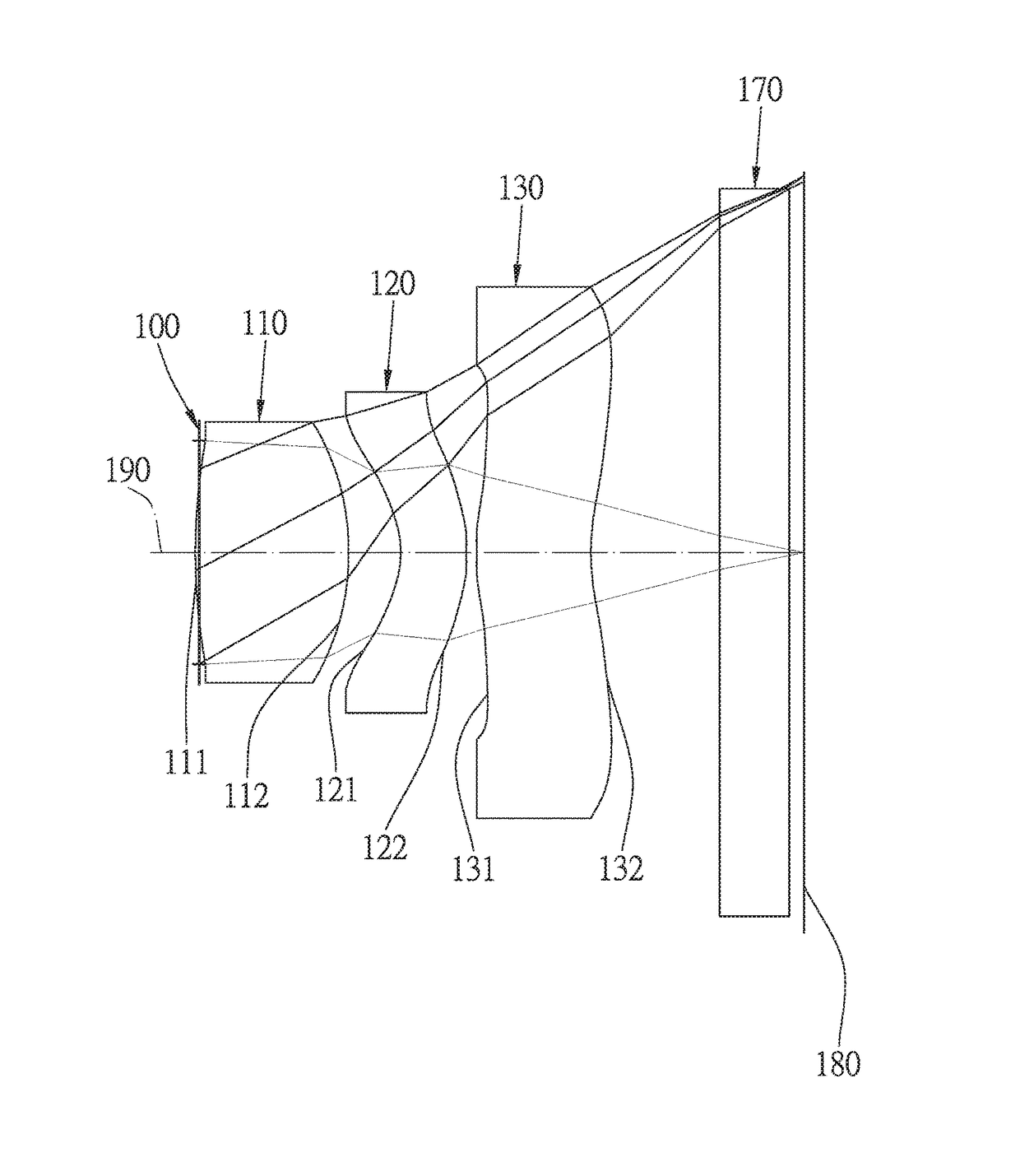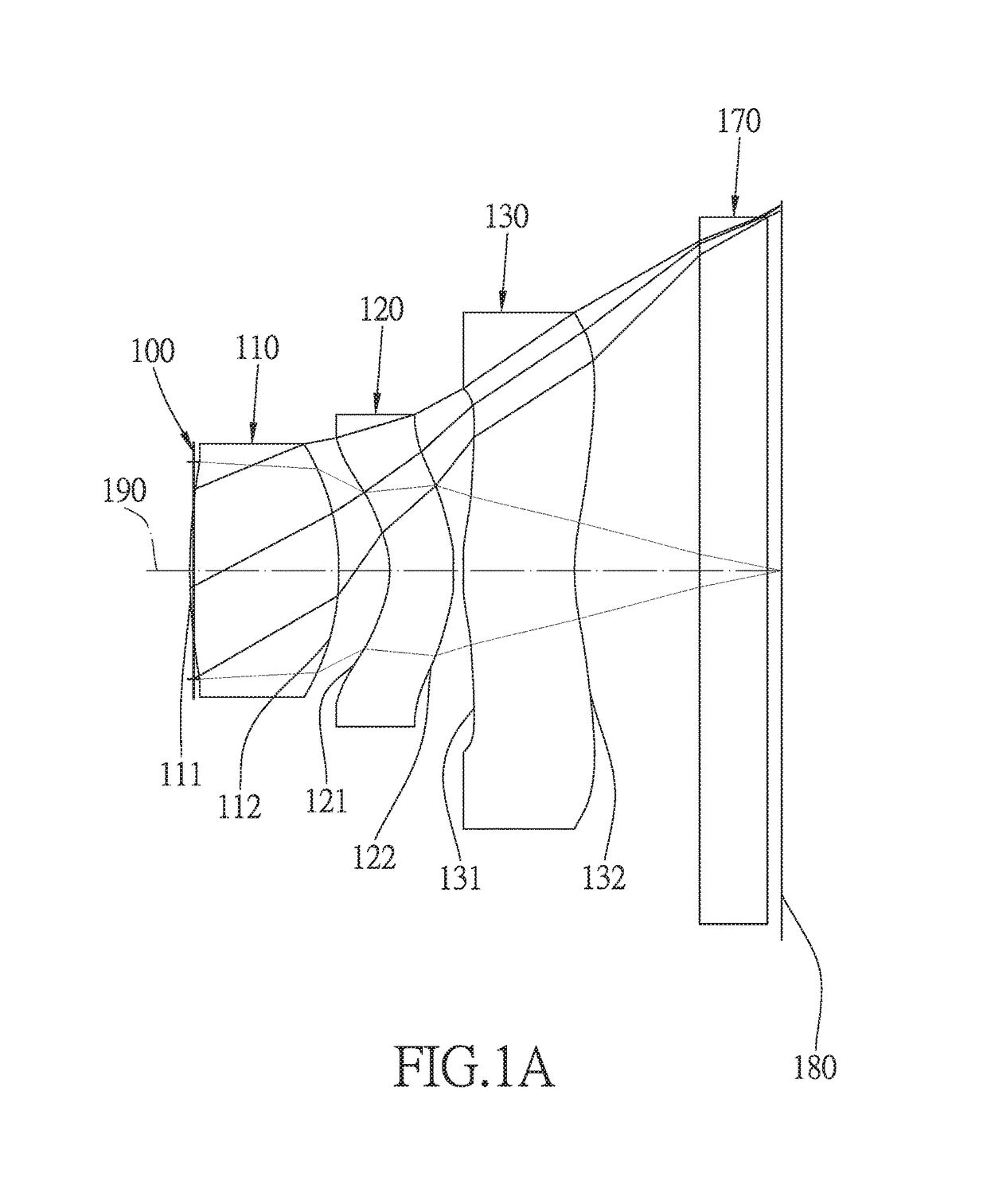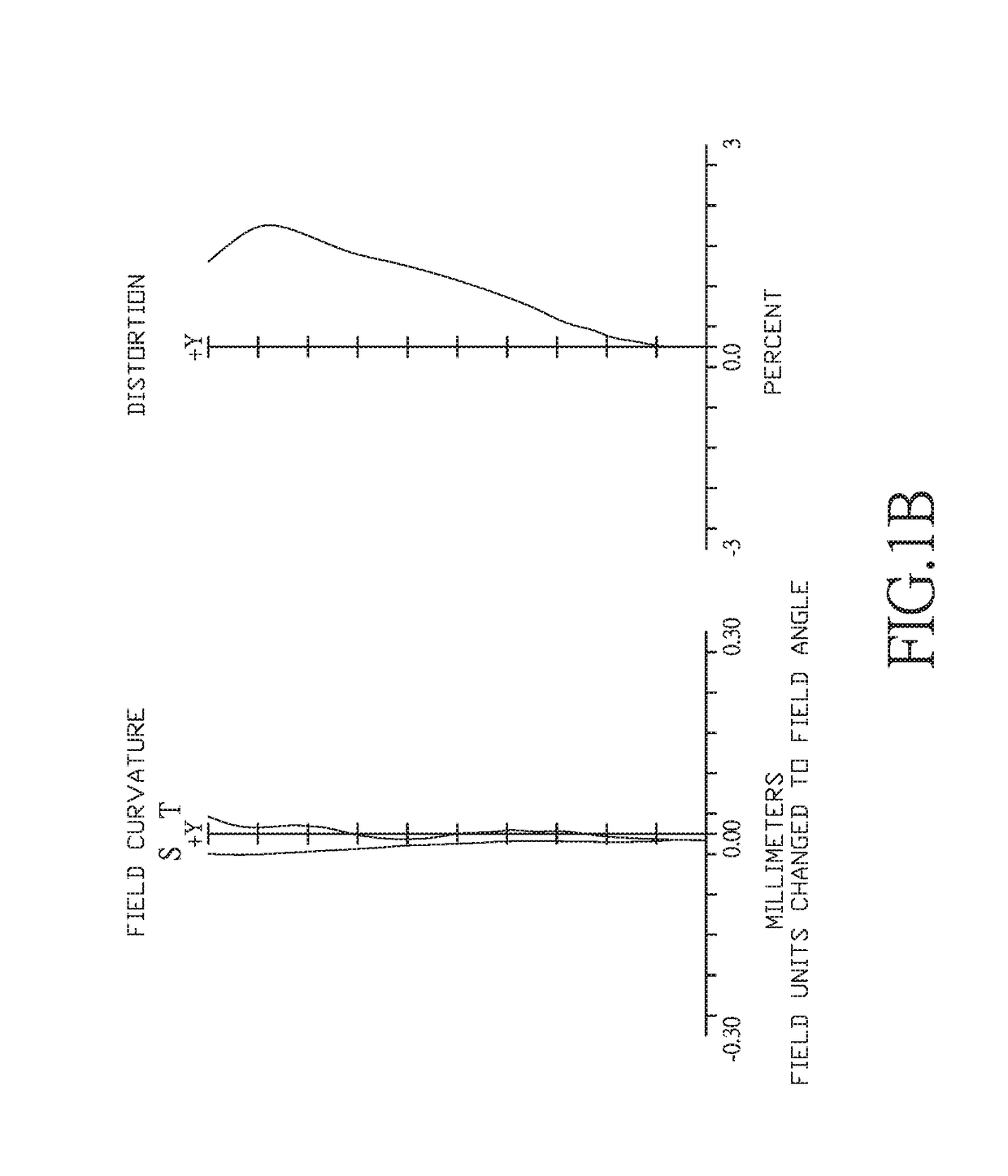Optical lens system with a wide field of view
a technology of optical lens and wide field of view, applied in the field of optical lens system, can solve the problems of increased distortion, larger beam, complex lens design, etc., and achieve the effect of reducing the length and extending the field of view of the optical lens system
- Summary
- Abstract
- Description
- Claims
- Application Information
AI Technical Summary
Benefits of technology
Problems solved by technology
Method used
Image
Examples
first embodiment
[0038]The equation for the aspheric surface profiles of the respective lens elements of the first embodiment is expressed as follows:
z=ch21+[1-(k+1)c2h2]0.5+Ah4+Bh6+Ch8+Dh10+Eh12+Gh14+…
[0039]wherein:
[0040]z represents the value of a reference position with respect to a vertex of the surface of a lens and a position with a height h along the optical axis 190;
[0041]c represents a paraxial curvature equal to 1 / R (R: a paraxial radius of curvature);
[0042]h represents a vertical distance from the point on the curve of the aspheric surface to the optical axis 190;
[0043]k represents the conic constant;
[0044]A, B, C, D, E, G, . . . : represent the high-order aspheric coefficients.
[0045]In the first embodiment of the present optical lens system with a wide field of view, the focal length of the optical lens system with a wide field of view is f, the f-number of the optical lens system with a wide field of view is Fno, the optical lens system with a wide field of view has a maximum view angle...
second embodiment
[0067]The detailed optical data of the second embodiment is shown in table 3, and the aspheric surface data is shown in table 4.
TABLE 3Embodiment 2f(focal length) = 1.24 mm, Fno = 2.0, FOV = 78 deg.FocalSurfaceCurvature RadiusThicknessMaterialindexAbbe #length0ObjectInfinity500.0001Infinity0.0002stopInfinity−0.0253Lens 10.886 (ASP)0.331Plastic1.54456.0001.0744−1.466 (ASP) 0.1215Lens 2−0.421 (ASP) 0.192Plastic1.65121.500−2.2916−0.694 (ASP) 0.1637Lens 30.477 (ASP)0.251Plastic1.53556.0003.14080.547 (ASP)0.3409IR-filterInfinity0.210Glass1.51764.167—10Infinity0.15011ImageInfinityInfinity
TABLE 4Aspheric Coefficientssurface#345K =−1.9566E+001.1982E+01−2.5128E−01A =−5.4445E−01−2.8218E+00−4.2590E+00B =1.2215E+00−2.2349E+005.6898E+01C =−7.7254E+002.1695E+016.5023E+01D =−6.2292E+022.5877E+023.6131E+02E =−1.5113E+041.7908E+03−1.1856E+04F =1.4333E+05−4.8661E+034.0487E+04surface#678K =8.9298E−01−5.8224E+00−3.6944E+00A =−4.1282E+00−2.0766E+00−1.8624E+00B =4.4471E+016.0519E+005.3892E+00C =2.9344...
third embodiment
[0076]The detailed optical data of the third embodiment is shown in table 5, and the aspheric surface data is shown in table 6.
TABLE 5Embodiment 3f(focal length) = 1.311 mm, Fno = 2.0, FOV = 84 deg.FocalSurfaceCurvature RadiusThicknessMaterialindexAbbe #length0objectInfinityInfinity1Infinity0.0002stopInfinity−0.0013Lens 1 1.424 (ASP)0.547plastic1.54456.0000.9374−0.690 (ASP)0.2035Lens 2−0.257 (ASP)0.236plastic1.65121.500−1.6126−0.463 (ASP)0.0307Lens 3 0.701 (ASP)0.345plastic1.54456.0002.7348 1.091 (ASP)0.1209IR filterInfinity0.145glass1.51764.167—10Infinity0.13011CoverInfinity0.4glass1.51764.167—glass12Infinity0.04513ImageInfinityInfinity
TABLE 6Aspheric Coefficientssurface#345K =1.7206E+00−1.0243E−01−2.3651E+00A =−7.4912E−01−3.7511E−01−3.7050E+00B =3.0527E+00−5.9026E+002.8943E+00C =−1.5457E+02−2.8241E+002.3647E+02D =2.2136E+034.9721E+02−1.1944E+03E =−1.8019E+04−2.7550E+031.4902E+03F =5.5048E+044.1785E+039.2168E+02surface#678K =−4.8653E+00−2.2993E−01−5.9393E−01A =−2.7900E+00−2.0212...
PUM
 Login to View More
Login to View More Abstract
Description
Claims
Application Information
 Login to View More
Login to View More - R&D
- Intellectual Property
- Life Sciences
- Materials
- Tech Scout
- Unparalleled Data Quality
- Higher Quality Content
- 60% Fewer Hallucinations
Browse by: Latest US Patents, China's latest patents, Technical Efficacy Thesaurus, Application Domain, Technology Topic, Popular Technical Reports.
© 2025 PatSnap. All rights reserved.Legal|Privacy policy|Modern Slavery Act Transparency Statement|Sitemap|About US| Contact US: help@patsnap.com



